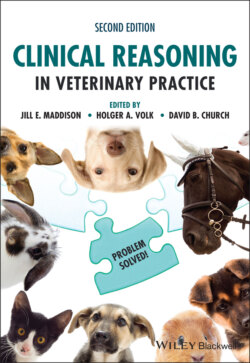Читать книгу Clinical Reasoning in Veterinary Practice - Группа авторов - Страница 55
ASSESSMENT OF THE PATIENT REPORTED TO BE VOMITING Define the problem
ОглавлениеIt’s important to differentiate vomiting from regurgitation, which involves the retrograde movement of food and fluid from the oesophagus, pharynx and oral cavity without initiation of reflex neural pathways other than the gag reflex.
It’s also important to differentiate vomiting from gastric reflux, which involves retrograde movement of food and fluid from the stomach into the oesophagus. This material may then travel some or all of the way to the pharynx and nasopharynx and may be inhaled, causing acid damage to mucosae it contacts. The severity ranges from subclinical to severe and life threatening. Many patients present for the respiratory consequences of ‘silent reflux’, but in this chapter we will focus on the presentation that can be confused with vomiting because material from the stomach comes out of the mouth.
It is also important to differentiate vomiting from coughing followed by gagging, which is often confused by owners with vomiting. Cat owners in particular may confuse vomiting and coughing in their pets.
Owners are often unable to differentiate vomiting, regurgitating, refluxing and gagging, and therefore it is important to ask specific questions to elicit appropriate information, for example, amount of effort involved, character of vomitus, etc. If still uncertain, the veterinarian may need to observe the animal. Even with veterinary observation, it is difficult and sometimes impossible to differentiate reflux and regurgitation without fluoroscopy. Without fluoroscopy, the concurrent problems need to be considered to reach a reasonable conclusion. Patients with nausea, vomiting and gastric dysmotility are predisposed to reflux, as are brachycephalic breeds.
